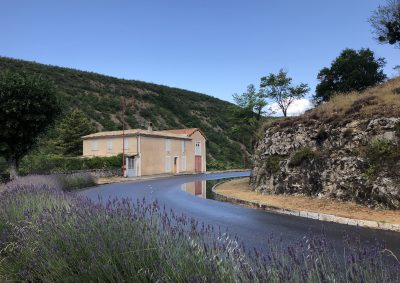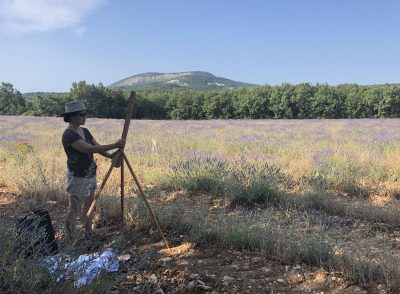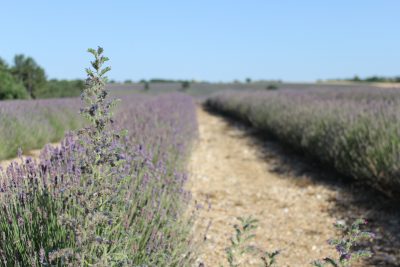My second Walk the Arts (www.walkthearts.com) experience. Last time was in Tuscany, Italy (2016), my introduction to hosts, art historian Prof. Yves Laroque and Mónica Marquez. I already knew what to expect when I ‘signed up’ for Atelier Provence: the location would be authentic and inviting; the program rigid; a small and varied group of people; jovial hospitality and special dining experiences. What more could I ask for?
Location: BANON (in Alpes de Haute, Provence, south-eastern France). A winding road trip from our meeting point in Manosque. Up, up to where the village nestles 760m above sea level, overlooking the Coulon Valley. Its beginnings are pre-historic (discoveries of Paleolithic remains have been numerous), with buildings structured mostly from ancient limestone and a history that ‘speaks’ as you explore.






Photos: the drive from Manosque to Banon; perched up high, with limestone buildings and sweeping views of the Coulon Valley.
Banon feels cosy, self-contained. My early morning walks were discovery adventures. Upwards through the cobblestone streets towards blissful blue skies, I was keen to capture the textures and enchanting house facades.






Photos: Morning walks, look up!






Photos: Homes sweet homes
On one morning, after a light shower, I was fortunate to catch this image where the cleared skies and lavender reflected a mauve wash onto the road.

Banon’s History – a delightful walking tour.
The first – and exciting – discovery was the Portal. There it was, looming above me on my first morning. Constructed end 13th/early 14th century for defensive purposes and to protect against epidemics, it was built by local corvée (obligatory unpaid labor). Mid 16th century, the Portal was rebuilt with a small shop inside which can still be seen when you walk through the underpass.
The Square Tower, at the foot of the path to the Portal (built early 17th century), its purpose was to provide additional protection to the surrounding buildings.
The Old Town Hall and Courthouse. Opposite the Square Tower, at the bottom of the pathway up to the Portal, it was used as a town hall, a classroom for education and the Palais de Justice (Courthouse). There was also a prison in the basement.






Photos: Walking up to the Portal, through it and from above; the Square Tower; the Old Town Hall and Courthouse.
The Upper Church, Romanesque, named after Saint-Marc and Saint-Just, Banon’s patron saints. It’s wrought iron bell cage can be seen from almost any aspect within the township or walking to the hilltop. The church was deconsecrated and is now a cultural arts space (see below for the exhibition I visited).
Family Houses, built along the Portal ramparts at the end of the 17th century.



Photos: Looking up to the bell cage of the Upper Church; Family homes
The Village: As with everything about Banon, I felt completely ‘at home’ as I observed early morning set-up for market trading and headed towards my morning coffee.






Photos: Market traders set-up their produce while locals stroll and I sipped coffee.
With a population of 970 (at 2016), the compact shopping strip offers all necessities; post office, pharmacy, general store, banks, delicious local produce and attractive hand-made giftware. Le Bleuet independent bookstore is widely-known, offering 189,000 titles. Banon has primary and secondary schools, a hospital and sports clubs.
A happy coincidence that my coffee spot, Les Voyageurs, was also my wine bar, where I watched the Banon world go by and sketched during our late afternoon ‘down time’.






Photos: wooden sculpture outside Le Bleuet bookstore; pâté and a whole lot more fabulous food; giftware lavendar shop; an impromptu glass of wine with Ellen, Amy and Carol; Les Voyageurs at night.
The Colours of Provence. Fields of lavender! The first thought that comes to mind. It’s there, an abundance of lavender, but we were also taken to other colour-rich settings.
Our first painting location was the Ochre Colorado Provencal near Rustrel. Unexpected, as strikingly similar to Australia’s central desert colours, the origins of ochre pigment. Here near Rustrel, it seemed more ‘creamy’ and cascading, in contrast to the infinite might and vastness of our deserts. What a joy to mix those colours and paint en plein air.






Photos: painting the ochres near Rustrel
Deep greens and heavy rain on the day Yves took us up Montagne de Lure to the abandoned chapel, Notre-Dame de Lure (12th century).
We were ambitious in setting up easels and preparing to paint amidst those majestic trees, but mostly we stayed inside the cold walls of the chapel.





Photos: Outside and inside Notre-Dame de Lure
Lashings of Lavender!
 Photo: Yves, striding through rows of lavender
Photo: Yves, striding through rows of lavender
With various shades of purple, Lavender is known as the springtime flower that produces a ‘calming’ fragrance. Embroidered lavender-filled sachets, essential oils, soaps and giftware are used to aid relaxation, sleep and other healing. Lavender also has symbolic associations with serenity, purity, the vitality and innocence of youth.






Photos: Hot, early morning, painting in front of Chapelle St Michel de Bertranat (constructed 1720); Heather, Cheryl and Claire taking some shade; Yves giving Claire instruction; Mapping the landscape; Lavender fields alongside our accommodation; Ellen with her artworks.
“Respect the mountain,” (Yves yelled at us). Another steamy, hot day and we set out early ‘in the footsteps of Cézanne.’ Oh yes, respect the mountain. Cézanne painted it more than 60 times, carrying 20kgs of art equipment from his studio, a long walk to the foot of Mont Sainte Victoire.
Afterwards, we strolled the streets of Avignon, sharing a fresh and delicious lunch.






Photos: Our group (from left) Claire, Heather, Cheryl, Carol, Amy, Ellen, Jean and me; yummy salads and pizza lunch, Carol and Amy; busy al fresco lunching in Avignon.
Next stop, the great Master’s home – Cézanne’s studio.






Photos: interior and exterior of Cézanne’s home and studio.
The Critique. On the last afternoon of the workshop, we displayed our works and had a group discussion about everyone’s art, including our own efforts.






Photos: Yves discussing Ellen’s work; Heather and Yves; Claire and Mónica; our group of artists with Yves and Mónica.
While our schedule was busy, I sought out ‘my time’ daily, not wanting to miss anything that Banon may have hidden. This group exhibition had just opened in the Upper Church. Serenely curated, it moved slowly amidst the white-walled spaces. Those Pilgrims were made from recycled plastic bags.






At the end of the Day (or perhaps, leaving the best ’til last).
Aperitifs, then wining and dining. This is when Mónica reigns, our busy day left behind while she and Yves entertain, the perfect hosts. No doubt they enjoy this as much as their guests. It’s the time to relax and get to know each other, indulge in everything, including laughter. Our evening meals were served on the terrace.






Photos: late afternoon, Amy with a beer and paint brushes; pre-dinner drinks, Cheryl, Yves, Amy and Heather; Mónica on the terrace; Yves in charge of the bbq; Ellen enjoys dinner; another delicious meal is served.
Say CHEESE, please! I have to write about it.
Banon, famous for its goats cheese wrapped in dry chestnut leaves and tied with raffia strings, produces over 600,000 individual units each year. The cheese factory employs 38 people (to whom I’m forever grateful). Banon cheese is the only appellation d’origine contrôlée (AOC) in the Provence Alpes Côte d’Azur region. Imagine that, protected species of cheeses! The annual Banon Cheese Festival – in conjunction with Le Bleuet bookstore and invited authors – is dedicated to the pleasures of table and mind. Cheese & books, Books & cheese…..just add local crusty bread and bottles of rosé. What a swell party.
Along with copious amounts of regional rosé, each meal at Atelier Provence finished with cheese, smothered on bread and sometimes dribbled with lavender honey. Let the photographs speak for themselves.






Photos: cheese and wine; Claire; Yves; Mónica and me; Carol and Jean; Yves and Mónica
Back at home with loads of memories, my camera bursting with images, artworks to mount and frame and a signed copy of Let Go! The Artist’s Way of Cooking, Yves and Mónica’s cookbook. It was in development when we were in Tuscany, they talked to us about becoming culinary “artists”. The 300 page book is a melding of their shared passions for Italian art history, fresh produce and colour. All recipes are Mónica’s as prepared and served at their workshops https://theartistswayofcooking.com






Photos: bubbles of fun with two of my favourite people; en plein air “painting in Provence”, late afternoon mist, les ochres de Rustrel, Cézanne’s Mont St Victoire; mounting and framing artworks; those two!
© Photographs and text Pamela Reid/tPRo 2020

